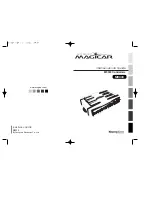
- 5 -
3. RECOMMENDED LOCATION OF ALARMS:
The
Consumer Products Safety
Commission
(CPSC) recommends the use of "At least
one
CO
alarm per household located outside each sleeping area" (see diagram
"A").
CO poisoning can happen anywhere in the home, but because most CO poisoning
cases occur while people are sleeping, the best location for the CO alarm is near the
sleeping area in the home. If there is more than one sleeping area in the home, (or on a
different floor) or if bedroom doors are closed during the night, you may need more than
one CO alarm.
Carbon monoxide at room temperature [68
o
F (20°C)] is slightly lighter than air
(density of 0.96716). However at 32
o
F (0°C) carbon monoxide is much heavier than air
(density of 1.250). Because the density of CO at room temperature is close to the
density of air, it disperses easily through the air, similar to the scent of perfume
dispersing uniformly in all directions. This characteristic makes it possible for
CO
alarms
to be mounted anywhere in the room or hallway, including both wall and ceiling areas.
v
Locate the first alarm in the immediate area of the bedrooms. If more than one
sleeping area exists, locate additional alarms in each sleeping area.
v
Locate an alarm in every room where someone sleeps with a door closed. The
closed door may prevent the alarm from waking the sleeper.
v
Locate an alarm on every level of the home.
v
For Mobile Home Installation see below.
v
DO NOT install unit within 5 feet of cooking appliances.
v
DO NOT install unit on any outside wall.
WARNING!
TEST YOUR CO ALARM AFTER MOBILE HOME HAS BEEN
VACANT AND AT LEAST ONCE A WEEK DURING USE.
BEDROOM
TV
ROOM
BR
K
DR
BR
DIAGRAM “A”
BEDROOM
BEDROOM
KITCHEN
DINNING
LIVING ROOM
BEDROOM
+
+
+
+
BEDROOM
BEDROOM
BEDROOM
+
+
+
CO alarm placement
for minimum protection.
Additional CO alarm
location for added protection.




























